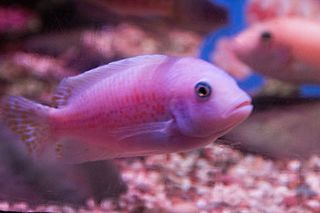
Cichlids are fish from the family Cichlidae in the order Cichliformes. Cichlids were traditionally classed in a suborder, the Labroidei, along with the wrasses (Labridae), in the order Perciformes, but molecular studies have contradicted this grouping. On the basis of fossil evidence, it first appeared in Tanzania during the Eocene epoch, about 46–45 million years ago. The closest living relative of cichlids is probably the convict blenny, and both families are classified in the 5th edition of Fishes of the World as the two families in the Cichliformes, part of the subseries Ovalentaria. This family is both large and diverse. At least 1,650 species have been scientifically described, making it one of the largest vertebrate families. New species are discovered annually, and many species remain undescribed. The actual number of species is therefore unknown, with estimates varying between 2,000 and 3,000.

Lake Malawi, also known as Lake Nyasa in Tanzania and Lago Niassa in Mozambique, is an African Great Lake and the southernmost lake in the East African Rift system, located between Malawi, Mozambique and Tanzania.

Lake Tanganyika is an African Great Lake. It is the second-oldest freshwater lake in the world, the second-largest by volume, and the second-deepest, in all cases after Lake Baikal in Siberia. It is the world's longest freshwater lake. The lake is shared among four countries—Tanzania, the Democratic Republic of the Congo (DRC), Burundi, and Zambia, with Tanzania (46%) and DRC (40%) possessing the majority of the lake. It drains into the Congo River system and ultimately into the Atlantic Ocean.
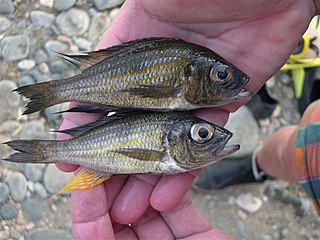
Aulonocranus dewindti is a species of cichlid endemic to Lake Tanganyika and some rivers which flow into it.
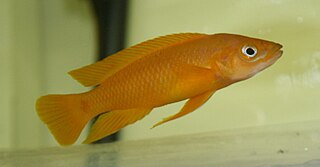
Neolamprologus leleupi is a species of cichlid endemic to Lake Tanganyika where it occurs throughout the lake. It is a recess-dweller, inhabiting cracks and crevices. It feeds on invertebrates living in the rich biocover of the substrate. This species reaches a length of 10 centimetres (3.9 in) TL. The color of this fish ranges from bright yellow to deep brown. Both color variations exist at each location where this species is found. This relatively small cichlid is a substrate spawner. It is easily confused with the very similar N. longior a fish also endemic to Lake Tanganyika. The specific name honours the Belgian entomologist Narcisse Leleup (1912-2001), who collected the type.

Grammatotria lemairii is a species of cichlid endemic to Lake Tanganyika in East Africa where it prefers areas with sandy substrates. This species can reach a length of 26 centimetres (10 in) TL. It is currently the only known member of its genus. The species is occasionally kept as an aquarium fish. The specific name honours Lieutenant Charles Lemaire (1863-1925) who was the leader of the Congo Free State Expedition, which collected specimens of fishes at Lake Tanganyika, including the type of G. lemairii.

The giant cichlid, also known as the emperor cichlid, is a species of fish in the family Cichlidae, endemic to Lake Tanganyika in Africa. It is the only member of its genus Boulengerochromis and tribe Boulengerochromini.
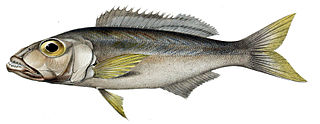
Bathybates ferox is a species of fish in the family Cichlidae. It is found in Burundi, the Democratic Republic of the Congo, Tanzania, and Zambia. Its natural habitat is Lake Tanganyika where it lives in shallow water and is exclusively piscivorous. The IUCN has assessed it as being a "least-concern species".
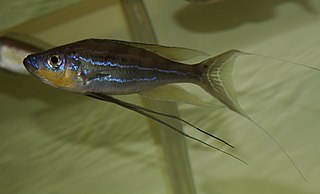
Benthochromis tricoti is a species of fish in the cichlid family. It is endemic to Lake Tanganyika in Africa and lives at depths of up to 100 m (330 ft). It feeds on small crustaceans and plankton. It reaches a maximum length of 16.5 cm (6.5 in). Like many other cichlids, it is a mouthbrooder.
Trematochromis benthicola is a ray-finned fish species in the cichlid family (Cichlidae), subfamily Pseudocrenilabrinae and the tribe Haplochromini. It is found throughout Lake Tanganyika in the Burundian, the Democratic Republic of the Congo, Tanzanian, and Zambian shoreline. Its preferred habitat are the hidden recesses of caves in shallow water.
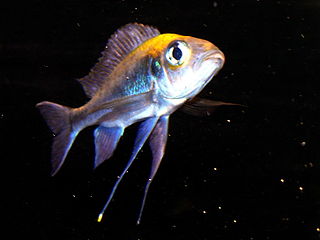
The featherfin cichlid is a species of cichlid endemic to Lake Tanganyika where it is found off rocky slopes. It feeds on plankton. This fish can reach a length of 21 centimetres (8.3 in) TL. It can also be found in the aquarium trade. This is currently the only species recognized in the genus by FishBase, but genetics and morphology suggest there are two valid species. The second is frequently called C. foae in the aquarium trade, but a review of the type specimen is needed to clarify if this is the correct name.
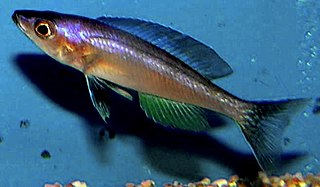
Cyprichromis leptosoma is a mouthbrooding species of fish in the family Cichlidae. It is endemic to Lake Tanganyika in Zambia and Tanzania. It seems quite common within its range and faces no particular threats, so the International Union for Conservation of Nature has assessed its conservation status as being of least concern.
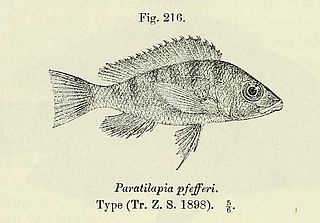
Gnathochromis pfefferi is an African species of fish in the family Cichlidae. It is endemic to Lake Tanganyika and its slow-flowing tributaries in the countries of Burundi, the Democratic Republic of the Congo, Tanzania and Zambia. It is common and widespread. This cichlid is found in relatively shallow waters, typically over soft bottoms in places with aquatic grasses.

The convict julie is a cichlid species in the subfamily Pseudocrenilabrinae family endemic to Lake Tanganyika. Hence it is found in Burundi, the Democratic Republic of the Congo, Tanzania, and Zambia. The fish is named after Charles Tate Regan.

Limnotilapia dardennii, the latticed cichlid, is a species of cichlid endemic to Lake Tanganyika, where it prefers rocky areas near the coast. It may also be found in the aquarium trade. This species is currently the only known member of its genus.
Neolamprologus buescheri is a species of cichlid endemic to Lake Tanganyika. This species can reach a length of 8 centimetres (3.1 in) TL. It can also be found in the aquarium trade. The specific name of this cichlid honours the collector of its type, the German ichthyologist Heinz H. Büscher.
Neolamprologus savoryi is a species of cichlid endemic to Lake Tanganyika. This species reaches a length of 8 centimetres (3.1 in) TL. It can also be found in the aquarium trade. The specific name of this cichlid honours Bryan Wyman Savory (1904-1988) who was the District Commissioner of Kigoma in the Tanganyika Territory during the Belgian Hydrobiological Mission to Lake Tanganyika of 1946–1947, this expedition collected the type.
Plecodus elaviae is a species of cichlid endemic to Lake Tanganyika. This schooling species is a scale-eater, plucking scales from other fishes. Both parents care for the offspring in this mouthbrooder. This fish can reach a length of 32 centimetres (13 in) TL.
Plecodus straeleni is a species of cichlid fish that is endemic to Lake Tanganyika in East Africa. This species can reach a total length of 16 centimetres (6.3 in).

Mastacembelus ellipsifer is a species of spiny eel that is endemic to Lake Tanganyika in Africa and sometimes kept in aquariums. Although sometimes called the Tanganyikan spiny eel, it is only one of fifteen spiny eel species in the Tanganyikan basin.
















